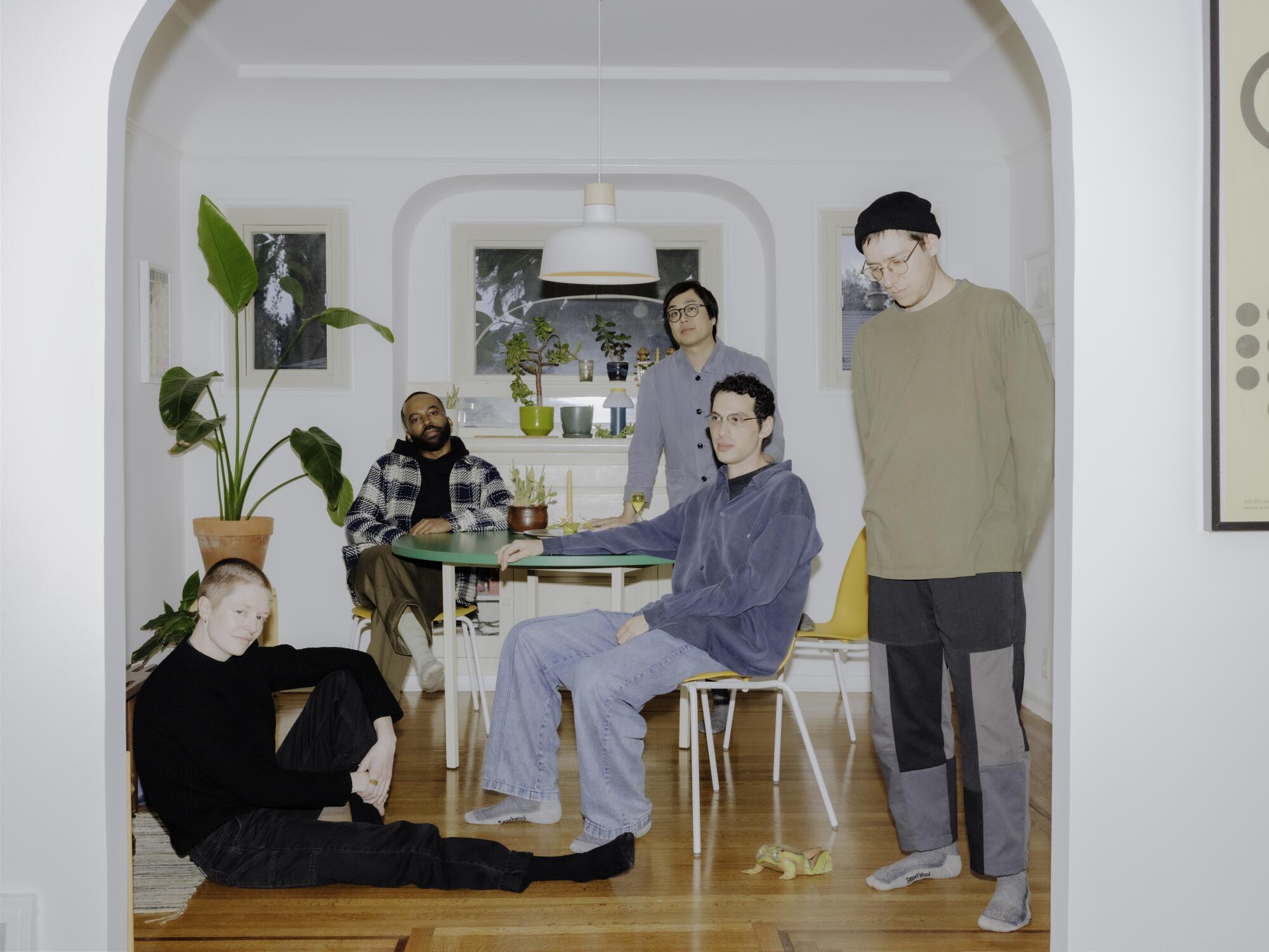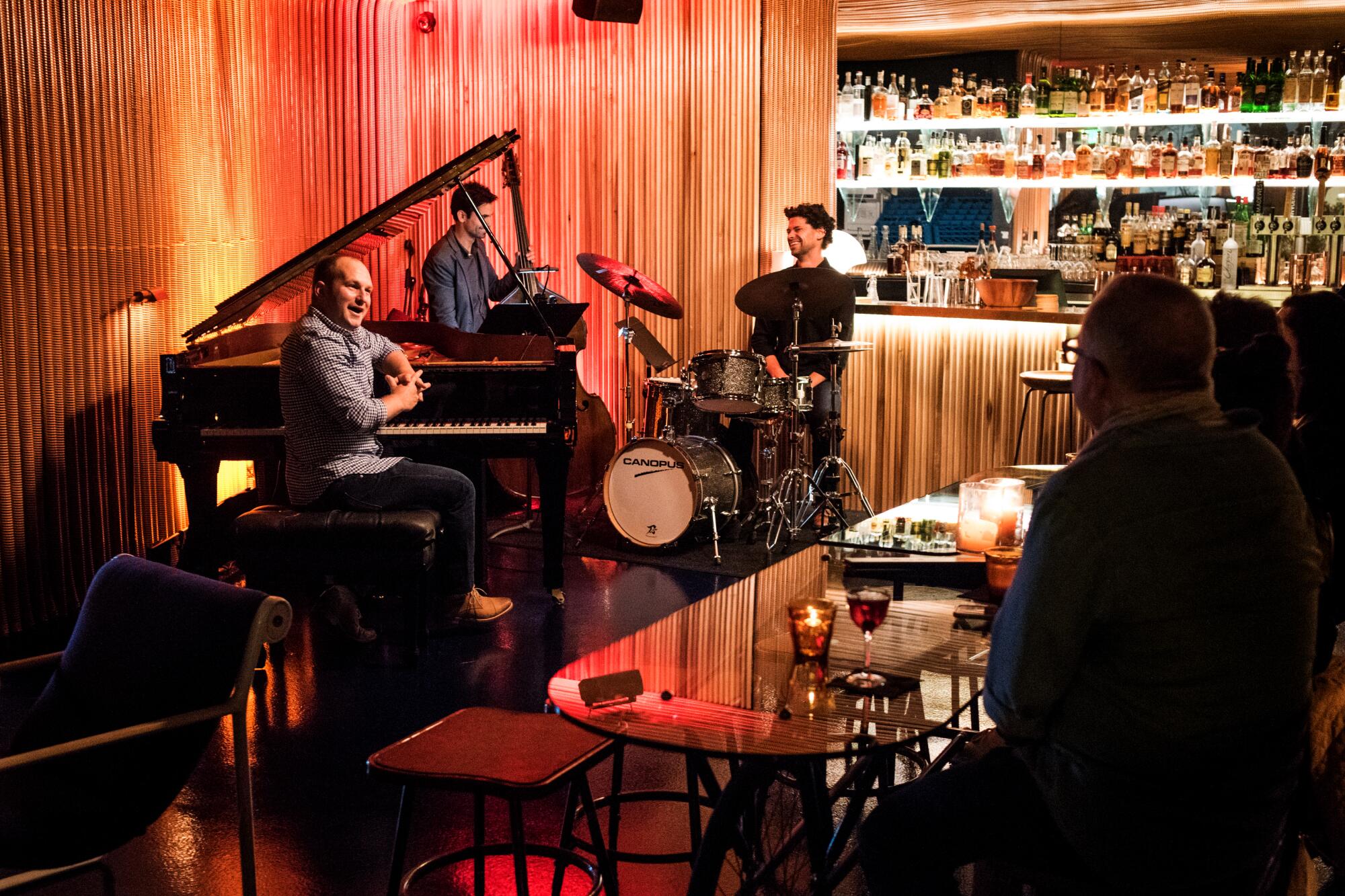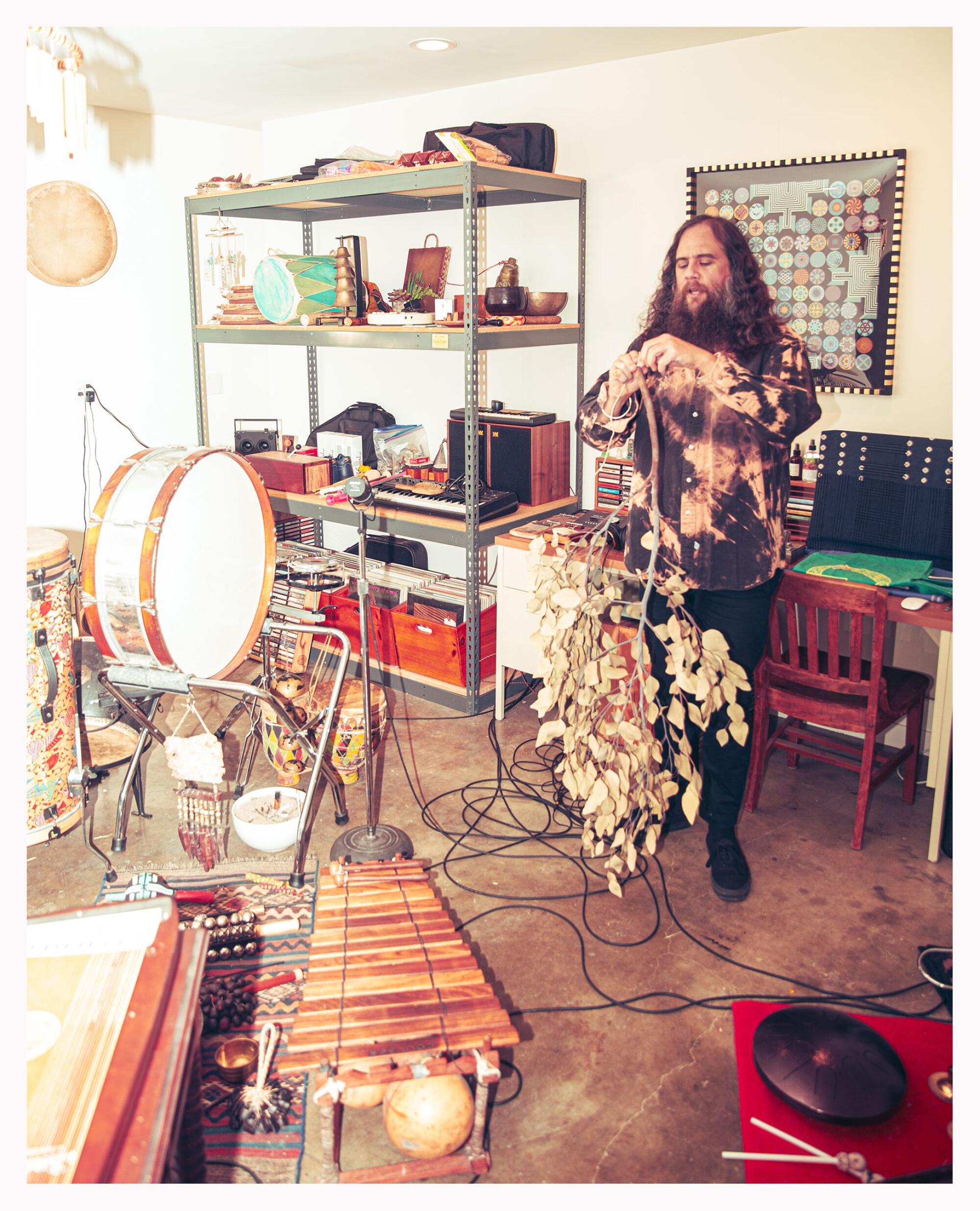The debut album from the L.A. jazz supergroup SML is a thrilling elegy for a dead nightclub.
Over two packed nights last year, the quintet recorded raw, long-form improvisations at the Highland Park jazz club ETA, a cramped bar and restaurant with tough sight lines that fits around 100 people. It wasn’t a perfect room for jazz, yet incredible jazz kept happening there.
“ETA was the kind of place where you really could experiment,” said SML’s bassist Anna Butterss. “They made it easy for us to come up with this group and not feel any external pressure other than what we wanted to do.”
The band’s June LP, “Small Medium Large,” which culled from those performances, couldn’t have happened anywhere else. It never will again. After seven years, ETA closed in December.
That such an exuberant album arrives in the club’s twilight is telling for modern jazz in L.A. The beloved Little Tokyo venue Blue Whale met the same fate during the pandemic, and like-minded clubs say it’s been challenging to keep consistent audiences since.
The city is brimming with jazz musicians releasing stellar albums and taking risks live. But is L.A. so expensive and disconnected that it’s risking such rooms?
“I think about how generative a time it was because of that space,” said SML guitarist Gregory Uhlmann. “It’s almost like going to school, where you meet the friends you have for the rest of your life. I’m sure there will be more places, but nothing will be quite the same.”
Last month, the members of SML met up at the Philosophical Research Society in Los Feliz, an esoteric art deco haunt for Butterss, Uhlmann, saxophonist Josh Johnson and synthesist Jeremiah Chiu (the band’s perfectly-named percussionist, Booker Stardrum, was on the road).
This group of friends has dizzying resumes beyond jazz; between them, they’ve recorded and toured with Phoebe Bridgers, Jason Isbell, Perfume Genius, M83, Meshell Ndegeocello, Leon Bridges and countless more.
But this band is an ultra-modern mix of hard post-bop, witchy electronics and meditative krautrock. Inspired by albums like Miles Davis’ 1969 LP “In A Silent Way,” they meshed live recordings (tracked by ETA’s ace house engineer Bryce Gonzales) with digital de-constructions. Synth washes and pinprick guitars bolster ferocious sax melodies, while the rhythm section plays with a sampler’s precision before blasting wide open.
It’s the kind of galvanizing project that only exists when musicians have a community to develop in. “We had a lot of kinship playing shows there, we just got each others’ sound palette and approach,” Chiu said. “Soon you started to see this scene of really tasteful players there.”

From left: Anna Butterss, Josh Johnson, Jeremiah Chiu, Gregory Uhlmann and Booker Stardrum of the jazz supergroup SML.
(Joyce Kim)
“It’s interesting to think that the physical space is no more,” said saxophonist Johnson. “But we will be hearing music created in and encouraged by that space for a very long time.”
For Ryan Julio, who booked the music at ETA, losing the club was “not unlike a death,” he said. “I had like a thousand people texting me to say ‘Sorry for your loss.’ But there was a part of me that was like, ‘If you’d have showed up this whole time, we wouldn’t have had to close.”
Julio cited a range of factors — a downturn in drinking, tough margins, the challenge charging a cover for local bands. “There’s all this hand-wringing about how much Taylor Swift tickets cost,” Julio said. “But we’re killing mid-level shows in L.A. It’s harder than ever. If you claim to value this, you’ve got to show up.”
L.A. has a long, storied jazz club legacy stretching back to Club Alabam, Billy Berg’s and the Dunbar Hotel. The Lighthouse Cafe in Hermosa Beach inspired Oscar-winner “La La Land,” and Dinner House M hosted generations of hard-partying jazz buffs. Veteran supper clubs like Catalina Bar & Grill, the Baked Potato and Vibrato draw older, monied audiences.
But for the small local venues that regularly present current, edgy jazz acts — the places were the music moves forward — this is a tricky moment.
“It’s super important to have that gathering place with a sense of stability to have a creative music community,” said Jeff Parker, a guitarist and jazz professor at the California Institute of the Arts (who had his own residency at ETA). “Some of the greatest musicians in the world are in L.A. right now. But it’s difficult to have a venue here. Everything’s so spread out. L.A. has always been notoriously hard to get people to come to shows.”
“It’s kind of a weird time,” said Emily Rose Epstein, a talent buyer at PRS and the Frogtown venue Zebulon that regularly hosts jazz acts (SML will play a two-night stand there July 8-9). ”We’re seeing the effects of the film industry strikes and work is slow for many people. The bar’s slower, and our costs of doing business are higher than ever. It makes sense that people are tightening their wallets, but we’re one of the only independent venues in L.A. left.”
“I just saw [Ethiopian jazz legend] Hailu Mergia in our tiny room, and it was so magical,” Epstein continued. “The people that find us are never bummed to stand beside other music lovers and watch something incredible. But I do wonder if people are priced out or focused on finding work.”
The L.A. label Jazz Is Dead books top-flight talent at the Highland Park venue Lodge Room, and label founder Andrew Lojero said that the caliber of musicianship here makes this a “special moment for the genre in L.A.” But he acknowledged that he’s “kind of torn. The future’s never been brighter in some ways, but in other ways, it does feel pretty consolidated,” when it comes to the club scene.
He cited the pandemic-era Shuttered Venue Operators Grant program as a possible model for supporting small venues. “That was a huge step towards a resurgence,” Lojero said. “What London and São Paolo have is government and cultural institutional support for music in ways that we don’t. But I still see L.A. at the forefront of it all. Jazz music’s roots run super deep here, and one of the best things we can do is to give artists spaces.”

Max Haymar of the Max Haymar Trio talks with the audience between songs at Sam First on May 5, 2018.
(Nick Agro / For The Times)
Paul Solomon, who owns the acclaimed jazz purist club Sam First, agrees that “The scene is super strong, but it’s been an enduring issue in L.A. that we tend to be short of venues,” he said. “We’re competing with the Netflix-ization of life and folks staying home. But cultural amenities provide the fabric for a neighborhood. That’s what makes the best cities.”
Sam First puts on two sets a night, five nights a week, and recently started a record label to release limited pressings of its live recordings. But Solomon acknowledges the dedicated jazz clubs left standing are facing headwinds.
“We’re focused on being that supportive small club for folks to play original music,” he said. “But the economics are tough. Even with musicians sacrificing to play music they want in a supportive place, the costs of paying for live music, versus what people are willing to spend to go out, it doesn’t always add up.”
The two-year-old, jazz-heavy venue The Sun Rose, inside the Pendry Hotel on the Sunset Strip, draws star-packed crowds for residencies by actor/musician Jeff Goldblum and Adam Blackstone, Rihanna’s music director, alongside underplays from John Legend and Robert Glasper.
“It’s almost impossible to make a profit on a 100-capacity room, so we’re really fortunate to be attached to a beautiful hotel,” said Sharyn Goldyn, the venue’s booker. “But there’s so much interest. Guests always hear about us because they were looking for great jazz clubs in L.A., and because we’re independent, we can be really selective and not beholden to bigger promoters.”

The trombonist Ryan Porter has a new documentary, “Resilience,” about his career and education in Leimert Park’s jazz scene.
(Abigail Lopez Photography)
Yet Ryan Porter, a trombonist best known for playing with Kamasi Washington’s band the West Coast Get Down, says L.A. needs tiny spots like Leimert Park’s World Stage, a nonprofit education and performance space that survives on small donations. It’s where they built the most influential jazz ensemble of this era in L.A.
Porter just played the Hollywood Bowl and released a new documentary, ”Resilience,” that focuses on his Leimert Park jazz scene and the late Reggie Andrews, a music educator at South L.A. high schools who taught Washington, Terrace Martin, Syd and Thundercat alongside veterans like Earth, Wind & Fire, Patrice Rushen and Tyrese Gibson.
“In the inner city, you can be a gang member or drug dealer, but most kids want to take their best steps,” he said. “Friends and music teachers inspired me through their work ethic, giving us a place to perform where we could take advantage of that expertise. Now it’s our turn to take care of them for the next generation.”
He hopes other venues like the Miracle Theater and Lavender Blue in Inglewood can hang on given the huge sports stadium investments nearby.
“When it comes to keeping the lineage of jazz in L.A. alive, there have been people who were selfless and sacrificed a lot,” Porter said. “For me back then, it was hard to understand why they cared so much. But it was because they saw potential in all of us so early, so we could see it for ourselves.”
As skyrocketing rents make life arduous for musicians and venues, some artists are adopting a looser definition of what a jazz club is.

The musician Carlos Niño, a legend in L.A. experimental jazz circles, helped create André 3000’s flute-driven LP “New Blue Sun.”
(Todd Weaver)
Carlos Niño, the uncategorizable mystic of L.A. jazz, is a percussionist, producer and kindvibed visionary. He backed up André 3000’s unlikely, chart-topping flute album “New Blue Sun,” and during André’s live performances, he’s as likely to be swishing palm fronds as any drumming. He just released “Placenta,” a wild and intimate album that’s rooted in jazz but evokes the visceral psychedelia of pregnancy and birth, inspired by becoming a new parent in his late 40s.
Niño definitely sees the value in clubs like ETA, Blue Whale and Townhouse in Venice. But he’s lately been more drawn to shows in nature, like the park events put on by the Living Earth collective, which pair live music and hiking, or the Leaving Records showcases in Elysian Park.
“In lockdown, I called everyone I knew with a piece of property and said ‘Help me present concerts,’” Niño said. “We had to be resourceful, but we weren’t going to stop creating something new.”
He also cited the roving house parties and DIY shows of SoCal’s Minaret Records as pairing the principles of the underground electronic scene with the intimacy of jazz venues.
“Maybe the model needs to change. It’s about supporting music, not going to a bar to drink and listen to a band,” Niño said. “It’s not about ‘We have no way to present music unless we have a permit and sell you drinks.’ The way I’ve done it is with as much diversification as possible so the art can stay authentic. It’s great to let things go sometimes, music will always find a place.”
As the members of SML gear up for their first shows since writing the epitaph for ETA on their album, they hope there’s still room for such clubs in L.A. — and crowds that care to fill them night after night.
“Only at the very end did it feel like everyone was trying to get into ETA,” Chiu said. “There are still spaces like that around town. But it’s just a matter of who’s willing to be the patron.”





